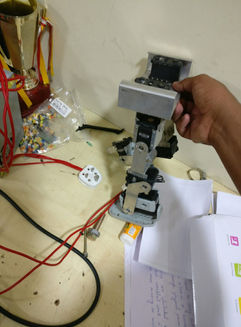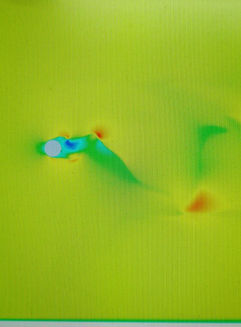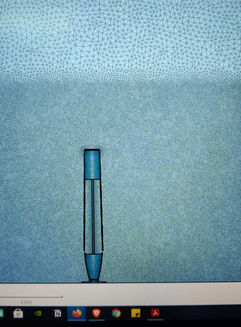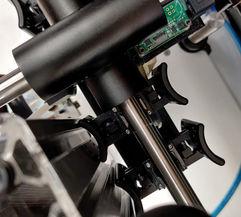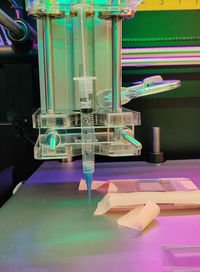
PROJECTS
Patient Specific Alveolar Ridge Implant for Periodontal Regeneration

I am developing a customizable bone scaffold/implant with Bone-cement using 3D Bio-printing to promote periodontal regeneration by segmenting the anatomic shape of the teeth-supporting alveolar bone from healthy model and reinstating it in target sites where bone loss took place due to periodontists (inflammation-induced bone loss) in diseased model.
The process involved obtainment of CT images, 3D reconstruction followed by segmentation, post-processing, Extraction and Finishing. I used open-source software like Slicer 3D, In Vesalius, Mesh-Lab et cetera. to make the research reproducible.
Bone-Muscle Interface
Developing the first personalized 3D muscle-bone implant that provides proliferation and differentiation of myoblasts and osteoblasts for accelerating bone formation/regeneration and storage/release of drugs to prevent tissue degeneration or excessive inflammation.
Working extensively with hydrogels and 3D bio-printing. The 3D Bio-printing Optimization Parameters taken into consideration:
-
Gel Viscosity
-
Nozzle Type and Size
-
Pressure and Printing Speed
-
Gelation Mechanism
-
Scaffold Material
-
Culture Conditions (for tissue maturation and function development)

Contouring Convex and Concave Mirror Using Iterative Intensity Integration Technique (IIIT Algorithm)
Our main objectives of the experiment is to develop an efficient and inexpensive way to find the thickness and deflection of the beams. IIIT algorithm requires two images to provide a result, hence the experiment is performed with contouring the reflected images from a priorly pre deformed surface from 2 different distances. IIT works on only 1D by contouring 2D reflective surface and hence requires gridlines, but it is not in the case of IIIT , the algorithm works for 2D as well. Hence the objective is to use the convex/concave mirror to compare the loading and unloading actions, by considering a reference plane from 2 different distances.
When the specular reflecting specimen is illuminated with a laser, the reflected intensity from it is made to fall on the screen, captured as the image at different positions of the screen. The intensity integration technique, which builds on the principle of energy conservation, considers the total quantity of light reflected off the specimen to be equal in both states. Iterative Intensity Integration Technique (IIIT), developed to contour deformed reflective plates(Mirrors). The cumulative sum of intensities, from the reference point (generally on the edge of the workpiece where the slope is zero) on both images, used as a correlation parameter, hence we can find slope in terms of the change in indices of a point along with the intensity array
Thermal Management Of Li-Ion Batteries by using Biopolymer Composites (PLA+PBAT+AT) as Separator
Lithium Ion batteries have been popular due to their High energy density, Low cycling costs, low maintenance, and comparatively low Self-Discharge. Those being the advantages it also is very dangerous considering their aging, limited transportability, cost and immature technology (still in development). But these features can be improved drastically by improving their separator properties. Though, there have been many studies taking Li-Ion batteries into consideration, only a selected few are on its separators and their effects.
This project focuses on targeting some of the disadvantages of current LI-ion batteries and improving them by altering the separator properties while using Plant-Based Bio-composites, to make the product Recyclable, Combustible or Composable. To achive this we used PLA + PBAT using MAH and GMA then added AT particles using E-BA-GMA as compatibilizer to PLA/PBAT Matrix to form PLA + PBAT + AT composite. With this we achieved 20-25 micro meter of separator thickness, 12.2% increased mechanical strength, 969% increased electrolyte uptake, and achieved 120 degree C and 171 degree C of thermal shutdown and meltdown temperature respectively. We also addressed the Green Impact i.e including Biodegradability, Carbon Footprint Decrease, Reduced harmful emission and impact on climate change. Adding to that the market study is also provided for further analysis.
Team Humanoid Enhanced Automated Robotic Assistant (T.H.E.A.R.A)
A fun Best-Out-of-Waste project. the aim of this project was to utilize all the unwanted materials and equipment in the lab and build a humanoid robot. The robot is built from PVC pipes, wood panels, and servo motors (not in best condition).
With all the unnecessary parts we decided to build a teleoperated differential drive humanoid with only 3 actuators. We developed control equations to implement pose estimation and tracking using Kinect in 2D plane.
It was improvised to implement the features in 3D plane and later the camera was also used to transfer live video feeds through VR headset to the user.
Automatically Navigated Teaching Robot Assistant (A.N.T.R.A)
A.N.T.R.A was the first company (Skeptical Group) issued project undertaken by me. The software solutions company, required a autonomous robot that had the capability to teach bridging the gap between the Indian Rural Society and Education.
The challenge was to complete the project withing a strict $500 budget. Hence the design was kept simple and limited the degree of freedom to 9 in total. To reduce the cost further we used differential drive for movement and even the manufacturing was performed manually in the lab.
We included automated attendance system, children tracking via geo fencing, child interaction, pronunciation, recitation and synchronization of rhymes and poems, meeting scheduling, providing authorized school content, making announcement, queue management and broadcasting climate updates and everyday facts on the software end.

Economic and Portable Device for Solar Powered Water Purification and Energy Storage
It takes more BLUE and less YELLOW to stay GREEN.
This project is a conceptual and calculative model developed on SOLIDWORKS problem statement "Sustainable Development." The device was made in order to solve the problems of Water and Power Necessities. The origin of this idea was the understanding of depleting and degrading water quality and the lack of electricity in the rural areas. We built this device with simple instalability and compactness for easy portability. The device utilizes the solar panels not only for generating the potential energy but also for heating the water. Operating with the copper tubes cover with glass on both sides and aluminum plate, the heat is trapped, hence, decreasing the heating time significantly. The heated water further goes through a 3 layered micro-filtration system. Using of simple components in a straightforward engineered solution, we devised a solution to eliminate power and water needs in an economical fashion.
4-Degrees of Freedom Manipulator with Motion Planning
Developed a 4-DOF manipulator prototype for specific pick and place operations to ease the logistic process for the company. Programmed to calculate the workspace areas and motion planning for obstacle avoidance on MATLAB.


Autonomous and Remote controllable Land Mine Detection Robot
This was my first ever competitive project in my undergraduate. We build an autonomous Land mine detection robot. The whole robot was based on the rocker-bogie mechanism and was build built with PVC pipes for light weight properties and wood plates for supporting the electronic body.
The rod connected with the detection coil was attached with a central servo which can provide a 360 degree rotation. Furthermore, the robot is equipped with a camera for object avoidance.





